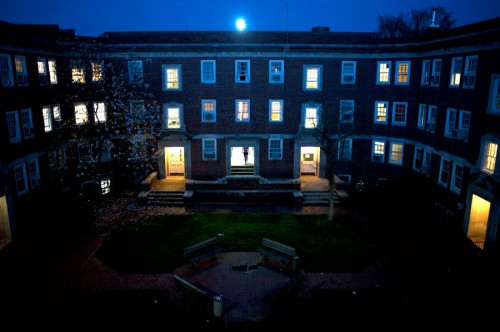
1. What make you interested in photojournalism and documentary photography?
I’ve been interested in photography since I was a little girl and used to get National Geographic at home. I got a film camera when I was in high school and took photographs of my friends and my first international trips to France with my best friends family. It wasn’t until college at San Francisco State University that I took a photojournalism course. I thought that documentary photography might help me travel, which I was already addicted to.
2. Can you describe some of experience of your first trip to china?
My first visit to China was in 2008 to Kunming. I had read about the city on ex-pat blogs and thought I might like being in a second-tier city near the mountains, in what I had heard was a beautiful and more easy-going place. I also thought that it would be easier to meet people and practice Mandarin in a lesser-known city with fewer foreigners. I had studied Chinese for three semesters at university and was totally unprepared for living in China. I remember I hardly understood anything (granted some people were speaking Kunming Hua and I never even realized at first!). I remember I was amazed by everything. I took a trip to Dali and Zhong Dian and felt like I was transported back in time. I lived in an all-Chinese apartment building on the outskirts of town and spent time riding a bike around photographing and hanging out with people I met on the street。I was amazed at how many people idolized American culture and still thought that Americans inevitably have a lot of money (this was before the recession). I was surprised by how much everyone stared at me and asked me all kinds of personal questions. I look back on it now and realize how big the leap was, and that I knew nothing about Chinese culture or character at that time. I was totally open to anything.
3.How about your last travel in china this summer. Is there anything that impresses you most?
My last visit to China was a much different experience. For one thing I spent more time with Africans than with Chinese in Guangzhou. I did interview a lot of Chinese shop owners but most of my time was spent with Nigerians. I became acutely aware of Chinese stereotypes about Africans, not only from stories that I heard from Africans but from what Chinese in Guangzhou told me. Maybe because I am American, Chinese would open up to me about their general dislike of Africans, how they consider them cheap and untrustworthy in business, that they sell drugs and bring crime to Guangzhou. I admit it was not everyone, but an overwhelming majority of Chinese in Guangzhou spoke negatively to me about Africans. As a journalist working on this story I would say I saw another side to the Chinese character that I didn’t get when living there as a white American. To be fair, there was a lot of animosity amongst the African community, too and generally a lot misunderstanding between both groups.
4. Your recent work focuses on contemporary patterns of international immigration. What make you explore this topic? Why you focus on china first.
I’ve been interested in immigration since high school. Growing up in California and living in San Francisco, I was surrounded by a diverse and rich immigrant history. I lived for six months in Guangzhou in 2009 and was fascinated by the large African community there so I decided to return and eventually made it my masters project. I decided to start working on the Chinese community in the US only when I got to Ohio University and noticed the surprising number of undergraduate students and realized it was a relatively new, national trend. I’ve always been fascinated by other cultures and languages and as someone who has lived in a few countries, I think it’s a natural fit for me.
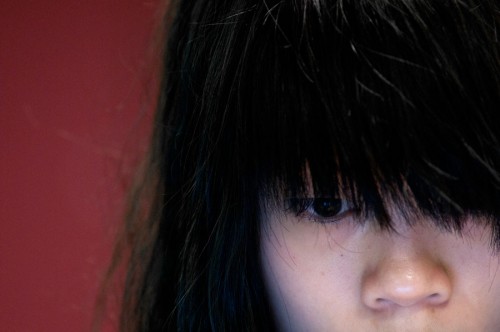
5. “Not here or there” project is about Chinese oversea students, why you give it such a title. From your view what these young generation are different from their parents.
It took me hours to come up with this title. I was pacing around passed deadline just totally stuck. I wanted to express the idea that these students had no idea what they were getting into when coming to Athens, that they were thrown into a culture that was not ideal for assimilation and that the situation in Athens led to few bridges into true cultural exchange. I wanted to convey the pressure they felt from their parents, who are paying huge sums of money for the prestige of an American degree, to get through school quickly. Many students are expected to return to China and begin a lucrative career, but are torn by their desire to learn and experience new things in the US. A very good editor made me start vocalizing what it is I wanted to say and “Not Here of There” came out. It represents the fact that these students are not entirely acclimated to American culture and the lifestyle here. Most tend to preserve a Chinese circle of friends and lifestyle, living inside of a Chinese cultural bubble. They are, however, immutably changed by the experience of being here, and are in limbo, torn between the more traditional cultural expectations back home and the freedom of living on their own in an American university town.

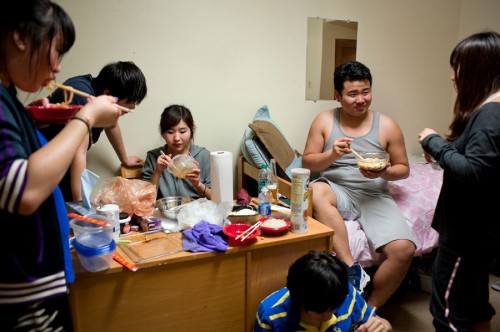
6. How long did you do this project? Finish or not. What is different for you to explore this story use photography not text? What kind of your strategy of telling the story by photo.
I worked on this story for 10 weeks in the Spring of 2011. I have stopped working on it as intensely, although I am still in touch with some of the subjects and even saw them in China this past summer. I think that using photographs to tell this story made it much more intimate for the reader. One of my goals was for our local audience to think twice about any stereotypes they might have about the Chinese students and understand the factors that have caused them to be so isolated in Athens. I think that the voices in the video and the images of these students made it easier to understand that every decision made by the university affects individual students lives in a very profound way.
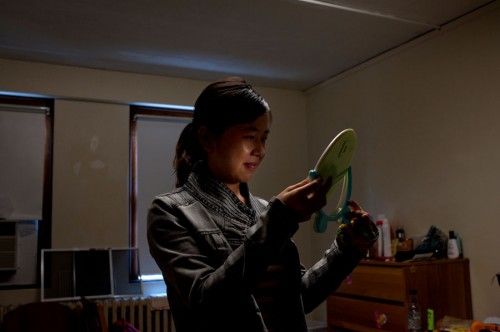
Clara Zhang, 22, is an International Relations major who arrived at Ohio University in March 2011. She lives in Scott Quad, where 83.7% of the residents are Chinese. Clara’s American roommate never showed up, leaving her to live alone in her dorm.
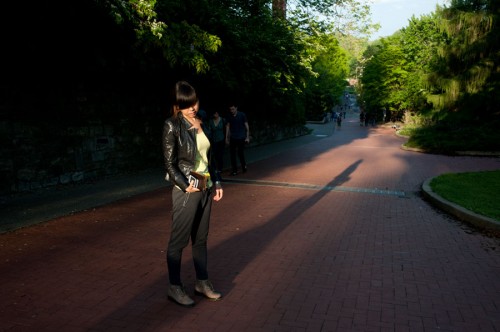
7. You say you are a visual journalist, what does it mean?
I changed my title from Photographer to Visual Journalist since I have been doing more multimedia, audio and video work. It seems in our field you have to branch out and do all kinds of photography, not just editorial and do multiplatform work to make a living now. There is a lot of freelance work in video and non-editorial photography so I wanted my title to show that I can do both. If I start trying to work freelance I will have to update my website to reflect those abilities.
8. Congratulations for the award form COPY. Can you introduce something about this competition?
COPY (College Photographer of the Year) is a competition for both undergraduate and graduate students in photography. It was founded in 1945 and is held at the University of Missouri so there is a lot of tradition behind it. For students here in the US it is heralded as a huge accomplishment to be recognized, mainly because of the amount of people who see your work. It is free to enter and open to international students as long as they are enrolled in university or have been during the year they enter. Photographers and editors in the journalism field judge the work and you can actually watch podcasts of the judging and the images as they make their decisions, which is really interesting. This year student photographers from 132 colleges and universities in 21 countries entered, and I was honored to have received two awards. While it is exhilarating to have been recognized, the point of the contest in many ways is to go through your work, organize it and reflect on your progress throughout the year.
9. Introduce some of your favorite book to us?
I was inspired by a lot of traditional American documentary photographers like Eugene Richards and love his books Dorchester Days, Americans We and Cocaine True, Cocaine Blue. I also love Laureen Greenfiled’s book Fast Forward about girls in Los Angeles and Eugene Smith’s Minimata.
10. Is there anything besides theses questions you want to share with us?
I would encourage Chinese student photographers to enter COPY. It’s free and open to all students. Also, there is a social networking site for photographers called lightstalkers that has helped me connect with photographers when I travel internationally that is also free to join. It’s an interesting time to be a photojournalist in China and I think exchange with journalists and photographers from other countries is a very positive thing. We can learn a lot from each other.
之前在网易上看到这套图片,下意识还以为是中国的记者拍的,没想到是正宗老外,哈哈!他里面对自己的visual journalist的定义很有启发,现在单反都能录像了,摄影记者拍照之余顺手录一段儿简直是举手之劳,加上阅读终端都这么multimedia了,看来以后摄影记者得会拍又会录啦 [:^^3:]
是的,可以更为宽泛地看待现在信息视觉化的发展趋势。不过,记者也要找到自己的重点和擅长。
我很好奇这样一个关于中国留学生的项目为什么会是由一位美国摄影师来拍?为什么不是由更了解中国人的华裔摄影师来拍?难道是因为我们对我们身边的事情太熟悉了,以至于熟视无睹或者甚至是麻木了,以至于让我们失去了作为摄影师所应具有的敏锐的观察力?
Robert Frank也不是美国人,可他拍的《美国人》却获得了相当多的美国人的认可。so 我觉得即使你不是某个圈子的人,只要你用心感受,用眼观察,用脑思考,用相机去拍,也一样可以拍出很棒的专题。 [:Automan:]
熟视无睹和人的境界不一样,视角就不一样
任老师,关于专题摄影内容的选取是这样么:先是有一个大致的拍摄意图和方向,最后在拍摄过程逐渐找到轮廓,等到最后完成照片的筛选时,专题的内容才这真正明确的凸现出来。拍摄的过程就是思考的过程,通过照片去进行最终的定位。而不是上来就给出一个十分明确的态度,否则到后来筛照片时会觉得失落。 还望任老师点拨……
就是这样的啊!应该逐步雕刻你的故事。
谢谢任老师肯定~~ 这段时间自己拍一组专题摄影,这几天筛照片时有点迷茫了……
故事出来应该有好几个反复的过程,开始迷茫也是正常的。另外,文德斯那个文章太长了,所以我每天翻译三段,蜗牛爬,哈哈。我愈发觉得他可真啰嗦。
不过啰嗦得蛮有意思的 [:^^2:] ~ 我是因为喜欢安东尼奥尼才喜欢上他徒儿的